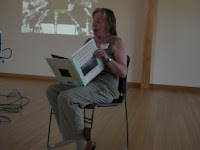Native Plants as Necessities
I read a book not worth blogging about this weekend, so that freed me to talk about some outdoor, book-free activities—which of course led to more books and thinking about books. Two of my kids and I spent Saturday morning volunteering at a native plant sale held by the Audubon Society of Central Maryland. The annual event supports two local wildlife sanctuaries and environmental education projects (including a schoolyard wildlife habitat grant program that I coordinate), but it’s worthwhile for its own sake as a way to encourage native plant and wildlife habitat gardening. Every year, the offerings grow more diverse, including ferns, grasses, groundcovers, perennials and woody plants, each with indisputable native provenance. We arrived before the crowds, and I altruistically resisted buying the ferns and chokeberries that I coveted, letting the customers get first crack at the goodies. By the time we finished hauling purchases to a few dozen cars, it was too late. But that’s ok; the plants are out there adding biodiversity to central Maryland, even if they’re not in my yard.
It occurred to me that my bioblitz site would have benefited if I’d bought at least some bunchberry to add surreptitiously to the near-monoculture of mown grass at my library. While I picked a lawn-like spot deliberately to see what grows & thrives in that common setting, it’s still been depressing to find so little. It makes me think that a new form of monkey-wrenching could be planting wild columbines to replace New Guinea impatiens and similar acts of sedition (seed-ition?). To learn about the damage we’ve wrought by the simple act of yard-construction, read Sara Stein’s Noah’s Garden: Restoring the Ecology of Our Own Backyards. Stein argues that our tidy lawns (and library grounds) are wiping out vast swathes of wildlife habitat, and that each of us has a responsibility to restore at least the patch around our home. Her efforts to transform six acres of Pound Ridge, New York are chronicled conceptually in Noah’s Garden and more practically in Planting Noah’s Garden: Further Adventures in Backyard Ecology. Stein also presents a corollary to her argument that native gardens are good for wildlife--that gardens and outdoor experiences are vital for children--in one of my favorite books Noah’s Children: Restoring the Ecology of Childhood. If that’s not enough gardening books for you, look for recommendations of books appropriate for each region of the U.S. at Plant Native. And if you'd like to witness how a natural landscaper-turned blogger transforms a misbegotten yard into a woodland oasis, visit Wild Flora's Wild Garden.
Sunday, my family managed a hike along the Little Patuxent River and also a visit to an Open House of Chesapeake Climate Action Network. At least once a year, Climate Action invites the public into its founder’s Takoma Park, Maryland home to see how much one family can do to reduce its carbon footprint. We admired a corn-powered stove, rain barrels, and high efficiency appliances, then chatted with a solar water heater installer and a biodiesel car owner. The kids gobbled solar oven-baked cookies, but it was the minescule electric bills that got my husband drooling. Equally attractive, there’s almost no lawn to mow, and blooms of field chickweed attracted a butterfly that would find no reason to stop by my blitz site. The buzz of human visitors, excited by all the possibilities around them, made me think that Sara Stein could extend her argument still further. People of all ages need gardens, outdoor experiences, and new possibilities for improving their environment to thrive. The crowds at the Audubon sale and the Open House were shopping for ideas, for hope.























